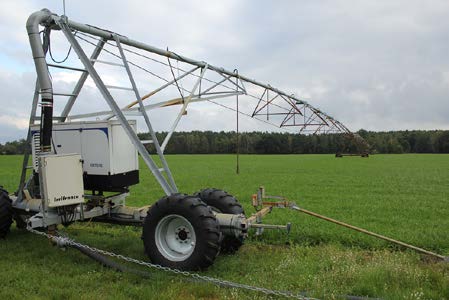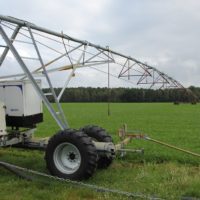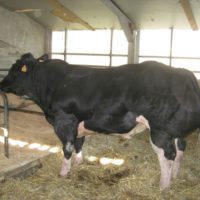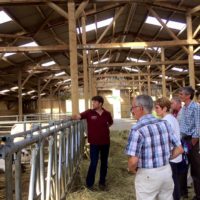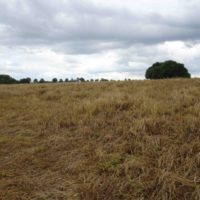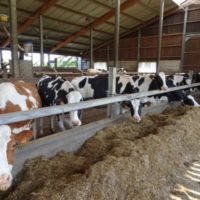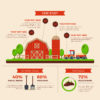Description
Background
The farm of Mister Andrzej Szulc is localized in the northern-east part of Wielkopolska voivodeship in the village Mikołajewo near the town Wągrowiec. Mr. Szulc runs a high efficient dairy farm producing large amounts of milk and breeds Holstein-Friesian cattle not only for own purposes but also for sale as high-value thoroughbred material. In the farm are also kept young bulls for fattening. At the moment of the creation of this case study he is farming on a total area of 146 hectares. The biggest difficulty that farmers from Mr Szulc neighbourhood need to struggle are the local very light sandy soils. Agricultural land near the Mikołajewo village is mainly localised on sandy soils with poor content of organic matter. This soils are strongly permeable and have no capacity for water retention. The drought effect occurs very quickly even in the times of minor water deficiencies. Plant production in Mr Szulc farm is divided into two parts. The first one is the cultivation of maize that is carried out on the 90 hectares of arable land. Maize for forage is produced in the farm in two different systems and it depends on the obtained final product. The farmer is producing classic silage out of the whole plants and also makes silage out of whole but shredded maize cobs (Corn Cob Mix). The second part is the production of forage on grasslands. The farm produces feed on both permanent and temporary grasslands. The permanent grasslands are localized on the area of 15 hectares and there is managed a typical meadow production thanks to with the farm can obtain an average number of 3 cuts per year. The main species of the botanical composition on those grasslands are: Festuca pratensis, Lolium perenne, Festuca arundinacea, Dactylis glomerata and Trifolium repens. The obtained sward yield is conserved as haylage. The main grassland forage production is obtained from the 36 hectares of temporary grasslands established on the arable land. This production is held in a very intensive way and towards different improvements and innovations, the farmer can obtain 4-5 cuts per year. The sown mixtures on irrigated area are based on highly productive varieties of ryegrass species (Lolium multiflorum and Lolium hybridum). On the non-irrigated area the alfalfa is sown. The whole plant production in the farm is set for the feed production. Not always it can be enough amount to secure the feed base, so the farmer purchases roughage on the local market and conserves it by himself. He tries to buy it especially in the time of abundance and stores it for the thinner times. Milk production in the farm is based on a herd of 180 milk cows of the Holstein-Friesian breed. During the lactation period, they are kept on a feeding system that provides a very high average level of milk production from cow and by a year its 11200 litres. With the youth animals that are retained for the renewal of the milking herd and young males for fattening in the farm is kept of 320 LU of cattle. Such high numbers and stable production of milk would not be possible to obtain by traditional farming and managing systems especially in the habitat of so poorly productive soils. The farmer had to search for new solutions and ideas to obtain higher and stable production of feeds especially in the case of periods of drought.
Detailed description
The farmer, through his own deduction and searching for a solution to the problem, decided to install an irrigation system on the farm. The first attempt to irrigate grasslands were made using reel-operated sprinklers. This solution gave good results, but it was very labor-intensive and expensive. Finally, the farm decided to implement a large investment and install a ramp transferred semi-automatic irrigation system. This investment was possible to realize thanks to subsidies obtained from the European Agricultural Fund for Rural Development from the Project PROW 2017-2013. Bridge irrigation system is working on the farm on two fields. Each installation is 220 m width prepared specially for the field size. It is driven by an electric engine powered by a generator. Water is obtained from deep wells and stored in artificial mid-field ponds. Maximum water flow of the installation is 45 m3/h and a topical dose of 15 l/m2. The dose is determined according to daily requirements. This installation can be working if it is necessary towards the whole vegetation season and can be used for 26 hectares of the arable land. The new obtained water conditions on the arable land have given the possibility to apply of seed mixture composed of high-yielding grass species: Lolium multiflorum and Lolium hybridum. These temporary grasslands are commonly used for two years.
Results
This solution allowed for the independence of field production from weather conditions, especially in the case of drought, and it has led to the possibility of using new grass mixtures containing high-yielding species and varieties. Thanks to irrigation the high application of fertilizers is possible leading to obtain high yield of DM and necessary amount of silage for dairy cows TMR feeding. These elements together with the introduction of an efficient technology of harvesting and feed conservation technique allowed not only to maximize the production of feed but also to reduce its unit production costs, allowing obtaining profitable milk production at a very high level. Presented elements directly have given the farmer a possibility to produce high amounts of feeds on the owned agricultural area and reduce the quantity of bought forage, decreasing the costs of milk production in the farm and had given chance to obtain higher profit.
Adoption criteria
The presented example shows that the implementation of an irrigation system can give evident effects in producing forage on temporary grassland in Polish site conditions. However this example is slightly extreme because the farm is located in a specific habitat characterized by light sandy soils, in which periodic droughts occur. The innovation can help to obtain better dry matter yields and a more rationalized production on grasslands in some similar farms that are producing feeds in an extreme habitat with water deficits. The irrigation of grasslands can be effective only when there is available a cheap source of water and a very effective system of irrigation. The irrigation of grasslands can be an interesting subject in the reality of climate changes and a higher threat of droughts. The installation located on arable land can be used not only for grass production but also for other arable crops.
Future prospects
In the farmer opinion, the obtained amounts of feed from grasslands are on a very high level and are satisfying for him. Still he is open to new solutions that can improve feed production especially obtained from grasslands. He is looking forward to implement an easy and low-cost system to automatically define the exact dose of water. In the farm there also appeared a problem with the change in legal regulations in Polish water law. Changes of the rates for the use of water (15 gr/m3 of deep well water), not taken into account at the investment planning stage, presently puts the profitability of using the irrigation system on grassland under a big question mark.

